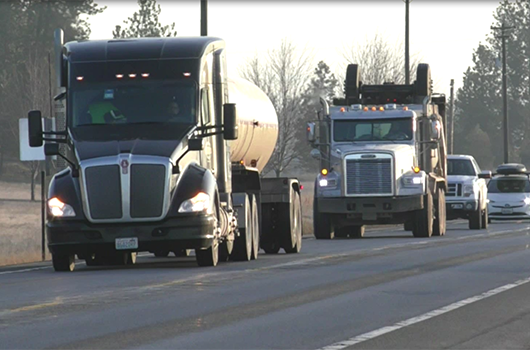Coeur d’Alene – In recent days, Idaho has experienced above average temperatures and precipitation which can lead to significant damage to highways, prompting state and local transportation agencies to enforce load restrictions. In an effort to reduce damage to roadways, the Idaho Transportation Department (ITD) has made the decision to restrict several routes in North Idaho.
Starting in the evening hours of Friday (Feb. 3) load limit restrictions will be in place on four state highways in the region: SH-3, SH-5, SH-54 and SH-53. Crews will continue to closely monitor road and weather conditions to determine if more routes will be subject to load restrictions in the coming days and weeks.
“Earlier this week we were able to lift the restrictions as weather conditions stabilized, but looking ahead we need to reinstate them on the same highways as before, plus now on SH-53 from the Washington State Line to US-95,” Operations Engineer Ryan Hawkins said. “On two-lane highways like SH-53, commuters will need to plan extra time to get to their destinations and expect to be slowed down by commercial vehicles respecting the restrictions.”
Learn more about why these restrictions are important by watching this video.
Restrictions on state highways are noted on 511.idaho.gov or on the app, which was just updated last week, in the trucker mode. They apply to trucks that have a gross vehicle weight rating of 10,000 pounds or more. On state highways, vehicles of this size are required to reduce their speeds to 30 mph and weigh no more than 14,000 pounds per axle. On U.S. highways, they still must reduce their speed to 30 mph but can weigh more in accordance with legally permitted loads. Breakup restrictions are not applied on interstates.
While restrictions have the potential to cause significant congestion on highways with a mix of commercial and commuter traffic, they are a necessary preventative measure that ultimately reduces impacts and costs to drivers and citizens in the long term.
As temperatures increase, the frozen base underneath the road thaws and becomes saturated with water, which creates a weaker section below the pavement that can lead to potholes and cracks. Heavy loads can cause rapid deterioration of pavement in these conditions.
Damage may result in months of additional repairs in the summer, diverting maintenance dollars from being invested into other routes.
These restrictions are only in place as long as necessary and save taxpayer dollars from being spent on damage that could have been prevented.

